
Product test
Cheap vlogging monitor review: solid idea, poorly implemented
by Lorenz Keller

The cheap smartphone screen from Patona was a flop. Will Rollei do better with a slightly different concept - and can I finally use the main camera for selfies?
I take a lot of selfies - both professionally and privately for social media. It annoys me that I only ever have the second-best camera on my smartphone for this, as the selfie cam is usually significantly worse than the main camera on the back.
An additional screen on the back can solve this problem. Unfortunately, the first attempt with a model from Patona failed miserably: the idea is good, but the implementation is not.
I'm not giving up yet and am therefore testing a second model that takes a slightly different approach. Rollei doesn't use a cable to connect the mobile to the selfie monitor - the connection is always wireless. Does this work better than the competition?
Neither on the packaging nor in the instructions does Rollei reveal which mobile phones the device is compatible with. I can see an iPhone in the product pictures - that's why I first tested it with an iPhone 15 Pro.
The screen can only be connected wirelessly - it works very easily. I switch on the screen and a quick guide is displayed immediately. I then tap on «screen synchronisation» on the iPhone and can select the Rollei. The iPhone's operating system is then shown on the second display.

Unfortunately, the instructions are too vague on this point. The German-language instructions are inadequately translated and refer to «Screen Mirroring» for the iPhone. You will search in vain for this on an iPhone set to German. There it says «Screen synchronisation». Such inaccuracies are tedious for beginners. I also had to google first to find the function.
The biggest problem with the screen quickly became apparent during testing: the image on the iPhone display and the external monitor are displayed in sync until I start a video recording. In my preferred setting with 4K resolution and 30 frames per second, the transmission has a delay of four to five seconds. That's hardly usable anymore.
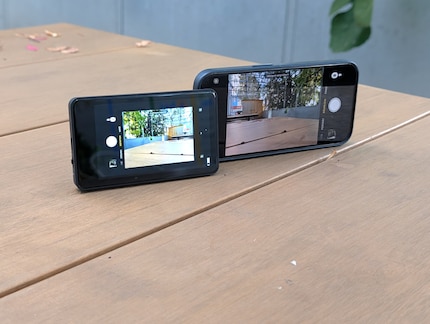
At least: As soon as I record in HD resolution or with 4K and 24 frames per second - or even just in HD - there is no longer any visible latency. So I have to do without my 30 frames per second if I want to use the Rollei. The best iPhone video quality of 4K with 60 frames per second cannot be set at all with a second screen connected.
While the 4K resolution is never completely stable with the competition from Patona, it is better with Rollei. If I hold back on the video quality, there are no stutters or delays.
The screen has a resolution of 480 × 800 pixels. The colours are pale and the display is framed by a thick, black casing. No comparison with the actual smartphone screen - the quality is visibly worse. If I want to check whether I'm even in the picture, that's enough. However, it's difficult to see whether my face is in focus and in focus.
With such a favourable device price, I guess I have to live with it. Why the manufacturer chose a screen with an aspect ratio of 15:9 is beyond me. Most smartphones have an aspect ratio of 20:9 or 19.5:9. The result of the wrong format: additional black stripes can be seen on the right and left. I can switch to the full screen width at the touch of a button, but this distorts the image.
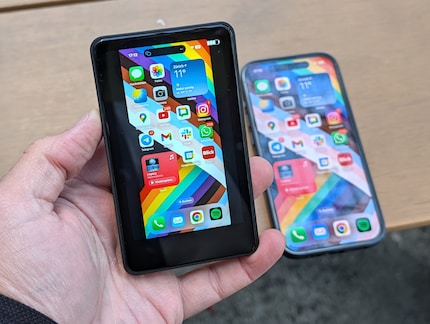
The Rollei screen is operated via physical buttons. I can use them to flip the image or adjust the brightness. They can also be used to adjust the volume of the integrated loudspeaker.
If I want to take a photo or video via the display, I also have to connect it to my mobile via Bluetooth. Unfortunately, the release button is in an unfavourable position and is also assigned to another function. This is not a good solution from Rollei, because I always have to look at the side to see which button is the right one.
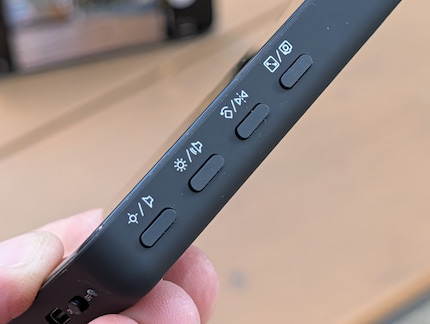
The Rollei selfie monitor has the typical MagSafe magnets built into the back. As with the competition from Patona, I can't charge the screen via this and have to connect a USB-C cable instead. The magnets are only used to attach the screen to the back of the mobile. However, the case is a little too long for the normal iPhone size.
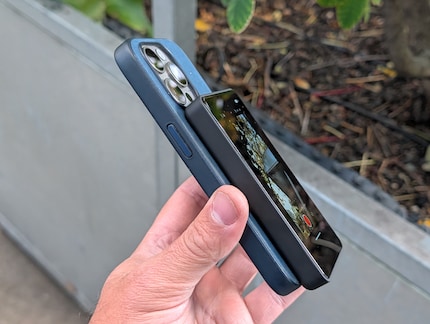
Rollei installs a battery with 1300 mAh. The manufacturer promises three hours of battery life. I measured two hours and 15 minutes when tested - that's fine and at least around 20 minutes longer than the competition. The screen also works when I connect a power bank - this can extend the runtime.
Rollei promises a range of 50 metres. After 15 to 20 metres, however, there is already interference in the image transmission. At 50 metres, the image does not break off, but instead of a live video, an updated still image is only displayed every 20 seconds or so.
The display should be compatible with Android mobiles, according to the operating instructions (but not on the packaging). Precise information is missing, such as which models are compatible and exactly how this works. The instructions are even less precise than for the iPhone.
Rollei relies on the Miracast standard - although I only found this out by searching the internet. Unfortunately, not all smartphone manufacturers support Miracast; Google, for example, does not. In the test, I was also unable to establish a connection with a Nothing Phone, although it should actually work here.
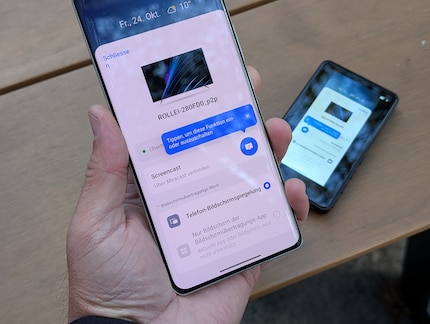
With Realme, Samsung and Xiaomi, on the other hand, I can quickly and easily connect my mobile and screen wirelessly. And once it's up and running, I even have advantages over the Apple world: I can record 4K videos at 60 frames per second - without stuttering or delays on the external screen.
Neither the monitor from Rollei nor the recently tested model from Patona were really convincing. They are only useful in very specific constellations.
iPhone: The Patona model with a cable connection works most reliably. The monitor is ready for use quickly and easily. If you want a wireless connection, the Rollei is more stable - but only if you set a maximum resolution of 4K with 24 frames per second.
Android: Make sure you check whether your smartphone supports Miracast beforehand - for example with a smart TV or Windows PC. If it does, you can use the wireless image transmission to the Rollei; this even works with the highest video resolution. With Patona, however, establishing a connection is much more complicated.
If you use an Android smartphone that supports Miracast, the Rollei selfie monitor is a useful and inexpensive additional screen. With an iPhone, it is only worth using if you do not set the full video quality. The Rollei model is priced at 55 francs. That's not a lot of money for a 4-inch screen with a battery and MagSafe - and again a little cheaper than the screen from Patona that has already been tested.
Overall, there are a few "buts", "onlys" and "ifs". The manufacturer is also disappointing when it comes to the details: the screen has the wrong format, for example, and the picture quality is not convincing.
Pro
Contra
Gadgets are my passion - whether you need them for the home office, for the household, for sport and pleasure or for the smart home. Or, of course, for the big hobby next to the family, namely fishing.